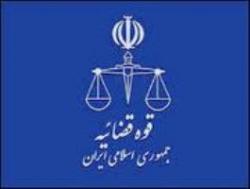
The Mehr News Agency reports that 900,000 cases are presented to the Iranian judiciary on a monthly basis, which adds up to 11 million cases per year.
Iran, however, has only 7,000 judges, and each judge has to handle 130 cases each month. Judiciary officials have confirmed these statistics for the past year, emphasizing that the number of cases far exceeds the capacity of the current number of judges in the country.
Last July, Mehr News reported that a Friday mass Imam in Qom, Ayatollah Amini, had made critical statements regarding the volume of judicial cases, emphasizing that it reflected badly on the Islamic Republic. He urged officials to take initiatives to reduce the number of cases and remedy the problem.
Ayatollah Amini was quoted as saying: “In order to recognize what is fair in each case, a judge needs a clear mind to make the correct decision in a peaceful atmosphere. But if he is swamped with too many cases, passing proper judgements becomes very difficult.”
He went on to add that it must be clearly determined whether it is a shortage of judges or other inefficiencies that keep the judiciary from extending due process to so many cases each year.
How many people are incarcerated each day?
One of the immediate results of the growing number of cases in the judiciary is a rise in the number of prisoners. In the latest Mehr News Agency report, the head of Iran’s prisons reported that last year the system had to deal with 55,000 more prisoners than in the previous year.
The justice department recently announced that there are currently 250,000 prisoners in the country, which is an increase of 30,000 prisoners compared to the statistics presented earlier. The report added that 80 people are incarcerated each day in Iran.
The prisons, however, do not have the capacity to accommodate these numbers. Official prison reports indicate that current capacities are only adequate to accommodate half the number of prisoners now behind bars.
Everyone is guilty
One of the main reasons for these startling statistics and the heavy load of judicial cases is that there are numerous criminal categories that get people sent to court through various police initiatives and land them in prison.
Farhad Tajari, a member of the Iranian Parliament’s judicial commission, told Khabar-on-line not so long ago that there are currently 2,000 criminal categories, which leads to more and more people being sent to prison each day.
When the new head of the judiciary, Sadegh Amoli Larijani, took over in August of 2009, one of his main platforms was crime prevention. Although he established a crime-prevention delegation, its proposed crime-prevention bill has not been enacted even after several years.
 The program was established to predict, identify and evaluate crime risks and take initiatives to eliminate or reduce them.
The program was established to predict, identify and evaluate crime risks and take initiatives to eliminate or reduce them.
The program suggests implementing policies and plans that range from preventing delays in due process to promoting a culture of crime prevention, and it calls for an increased budget for crime-prevention programs.
The crime-prevention bill was approved by Parliament but encountered resistance from the Guardian Council. After a return to Parliament, the bill is currently awaiting approval by the Expediency Council.
In the absence of social institutes
In Iran, anyone who runs into a problem, be it a family problem or a financial problem, will initiate legal proceedings. Legal advisers say people need to be encouraged to focus more on resolving their problems and conflicts rather than just turning to the judiciary. Furthermore, the definition of crime must also be reconsidered with the goal of reducing the number of actions deemed to be criminal, and thereby reducing the caseload.
Legal experts also suggest that many of the cases now being handled by the judiciary could be delegated to alternative  dispute-resolution bodies. In addition, if services such as social work and urgent-intervention programs are promoted, many of these judicial cases might never be initiated.
dispute-resolution bodies. In addition, if services such as social work and urgent-intervention programs are promoted, many of these judicial cases might never be initiated.
Crime-preventions programs are sadly absent from Iranian government initiatives; therefore, the help and the educational efforts of NGOs could be very effective in filling this void. Unfortunately, the government restrictions on these NGOs severely limit the reach of their efforts.
Experience in other countries has shown that people prefer to resolve their conflicts and disputes in accessible alternative-dispute resolution bodies before considering litigation. Iran’s Council of Dispute Resolution may have been established for such a purpose, but its structure prevents it from making any positive intervention, thus it has only become another part of the dysfunctional judicial process.
Who is involved in litigation?
Both civil and criminal cases comprise the glut that clogs the judicial system. Some involve bounced cheques, divorce or drug abuse, while many others concern crimes of various forms.
 A ministry of welfare official says even if half of current cases were civil, at least seven million people would be involved in criminal cases, and if the family members and plaintiffs were added, the number of people involved in litigation would be somewhere between 13 million and 14 million.
A ministry of welfare official says even if half of current cases were civil, at least seven million people would be involved in criminal cases, and if the family members and plaintiffs were added, the number of people involved in litigation would be somewhere between 13 million and 14 million.
Social conditions, vulnerability to crime
While some judicial cases may be closed through a redefining of crime categories and the promotion of alternative-dispute resolution, crime rates remain high in Iran.
The set of conditions and elements that lead to crime in a country cannot be ignored. The economic, cultural, social and psychological conditions now engrained in society as a result of government decision-making have made Iranian society more prone to criminal activity.
Financial and political insecurity coupled with economic concerns become underlying factors in mental and psychological disorders, which lead to new crises in the family and social framework. These elements put citizens always on the edge, which very often lands them in court for the simplest of conflicts.
[translated from the original in Persian]








